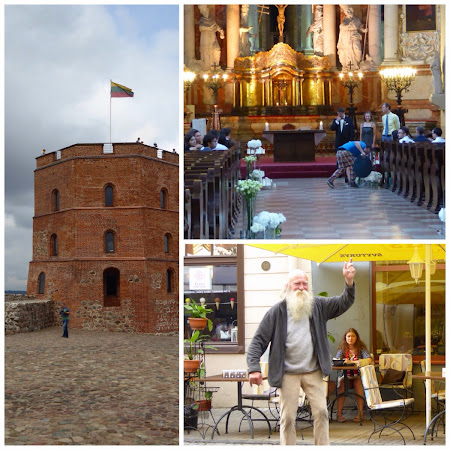We flew from Paris to Vilnius, the capital of Lithuania. A flight of about 2 1/2 hours.
The 3 countries (see map below) share the common history of being occupied by Sweden, Germany, and Russia at various times. Broadly they obtained independence after WW1, and were invaded by Germany and then 'liberated' by Russia in WW2. With the collapse of the Soviet Union they regained independence in the early 1990's. All are now members of the EU, and since 2004 also members of NATO.
Latvia introduced the Euro this year, Lithuania will next year, and Estonia has had it for some years. Each country has its own language. Latvian and Lituanian are similar 'Baltic languages' while Estonian is very different and we are told it has similarities to Finnish and Hungarian! Each capital city has an historic old city centre, and it was in these areas that we spent the majority of our time.

We also saw quite a few people begging, busking or both in the streets, including this old gentleman who was dancing and singing to the music of a friend on piano accordian.
It appeared to us that the Lithuanians are very proud of their heritage, language, and independence. However we were left wondering what the future will hold. Apart from selling amber jewellery to tourists what do they have? There are large rural tracks with the old communist collective building deserted with the return of land to private ownership. However many other EU countries have more productive land with a kinder climate. Vilnius gets down to -35C; children do not have to go to school when the temperature is below -25C. Vilnius has a prestigious University, but we suspect that many graduates quickly move away.
 In WW2, the Germans crowded Jews into 2 small inner-Vilinus ghetto areas. Most did not survive the war and there are few Jews today in the Baltic States. The statue (photo, left) is of a Jewish doctor remembered for his work in WW2. In Lithuania we visited 'The Hill of Crosses' (bottom right). The crosses have been placed here for hundreds of years. During the Soviet years they were often removed over night, but they were always replaced. They received a big jump in numbers before and after Pope JP2's visit for a mass! There are thought to now be over a million! We added one. There are many Russian speaking immigrants in all 3 Baltic States, brought to establish industries during the Soviet Communist era! In Latvia they are 45% of the population.
In WW2, the Germans crowded Jews into 2 small inner-Vilinus ghetto areas. Most did not survive the war and there are few Jews today in the Baltic States. The statue (photo, left) is of a Jewish doctor remembered for his work in WW2. In Lithuania we visited 'The Hill of Crosses' (bottom right). The crosses have been placed here for hundreds of years. During the Soviet years they were often removed over night, but they were always replaced. They received a big jump in numbers before and after Pope JP2's visit for a mass! There are thought to now be over a million! We added one. There are many Russian speaking immigrants in all 3 Baltic States, brought to establish industries during the Soviet Communist era! In Latvia they are 45% of the population.Shortly after entering Latvia we visited Rundāle Palace, is one of the two major baroque palaces built for the Dukes of Courland, before the territory was absorbed into the Russian Empire. It was an impressive palace and garden considering it was for an 18th C Duke. We found ourselves gate crashing a wedding reception complete with attendants in period customs.

No comments:
Post a Comment